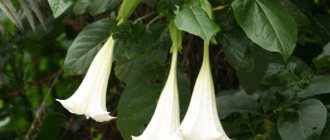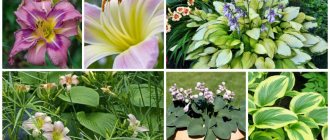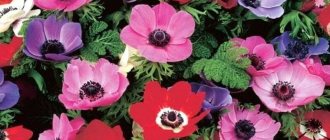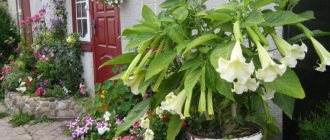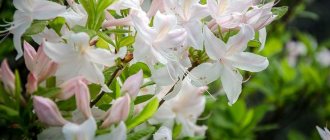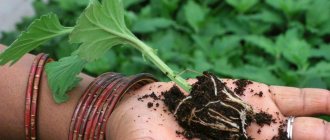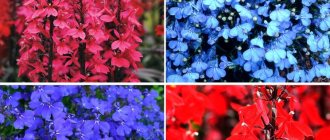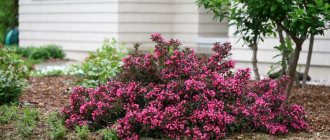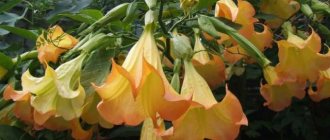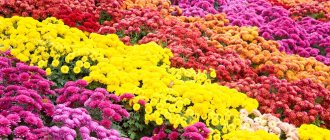Description
The Brugmansia flower acquired the name “intoxicating tree” due to the presence of a strongly odorous substance in different parts.
The name “angel trumpets” is associated with the shape of the flowers, which look like small gramophones and bells. It grows in the form of a bush or small tree, very fond of warmth. Under natural conditions, this is a fairly tall plant, at home the height is up to 2 meters. The shoots grow actively in spring and summer, but become woody slowly. To form a beautiful crown, they must be removed regularly.
Leaves with cuttings, smooth edges, with fluff on the surface. The root system develops quickly, forming a clump close to the surface, while at the same time sending several long roots into the depths.
This ornamental bush gained popularity thanks to its beautiful, relatively large flowers (length up to 25 cm, diameter up to 15 cm). They are fragrant, the smell is more intense in the evening.
The color depends on the variety; flowering is wavy and begins after the above-ground part has fully formed. The Brugmansia fruit resembles a gray hot pepper (see photo) with a length of up to 12 cm, the seeds are in the form of small “cakes” with a diameter of 1 cm.
Varieties
Popular varieties:
- fragrant (fragrant) - imported from Brazil, blooms indoors under favorable conditions all year round, flowers are white (sometimes light green);
- golden - long leaves (up to 50 cm), yellow-orange flowers;
- snow-white (woody) – white flowers;
- bloody - flowers are bright, red, orange, less often yellow, tolerates frost well;
- multi-colored - the young bush has white flowers, with age the color changes to orange, peach, length up to 50 cm.
When grown in the garden, buds of all varieties form late. In the spring, indoor plants can be taken outside without fear that they will freeze.
Features of growing Brugmansia from seeds
In practice, not all gardeners undertake to grow Brugmansia from seeds at home. This is explained by the fact that the process is labor-intensive, and the result cannot be predicted. The fact is that with this method of propagation, mother plants do not transmit varietal characteristics: shade, size, flower shape. It is almost impossible to predict in advance what Brugmansia will be like. But those who decide to try to grow an exotic beauty at home must start by choosing high-quality planting material.
What do Brugmansia seeds look like?
The plant scatters its seeds on its own. They ripen inside a pod - pear-shaped or elongated. Its size is about 12 cm. The seeds themselves are more interesting in appearance. Large and slightly flattened, they have an irregular triangular shape. Their surface resembles tree bark and has a brownish color.
The best time to collect seed material is September. Gauze bags are attached to the fruits in advance.
If the testes do not crack on their own, they are cut off, divided into parts and the planting material is removed
When will Brugmansia grown from seeds bloom?
As a rule, Brugmansias begin to bloom in the second or third year after sowing. The culture is known for its large and bright bell-shaped flowers. They bloom on the bush in July and remain until December. Under favorable conditions, abundant flowering lasts all summer.
Landing
Brugmansia is mainly grown in large containers. It should be planted in open soil in regions with warm climates, since the plant is very heat-loving and does not tolerate frost easily.
A shrub grown in a tub needs to be replanted several times a year, because it grows quite quickly, but this must be done carefully - by transshipment. The container should be quite deep and wide
For good growth of Brugmansia, nutritious soil with any acidity is preferable.
A soil mixture for palm trees is often used, but you can prepare it yourself from mixtures mixed in equal proportions:
- peat;
- humus;
- sand.
You can also take rotted leaf soil, peat, humus, perlite in equal parts, adding turf soil (2 parts).
Deadlines
It is recommended to plant Brugmansia in open soil at the end of May, when the threat of night frosts has finally passed. The optimal temperature for the shrub in summer is +18–28°, and in winter – +8–12°. Based on this, experienced gardeners recommend cultivating the flower as a tub crop, since in the middle zone it will not overwinter in open ground.
Technology
It is recommended to treat the planting substrate with a light solution of potassium permanganate. It is imperative to place drainage at the bottom of the tub or planting hole, as well as compost or manure, then place the plant along with a ball of earth and sprinkle it with soil mixture.
You should choose a place for planting or placing a tub with Brugmansia that is well lit, but the light should be diffused. The flower should be protected from drafts. It must be remembered that in the shade the angel trumpets will bloom sparingly, but the foliage will be numerous.
How to prepare seeds for sowing
The recommended time for sowing Brugmansia seeds is from the beginning of January to the end of March. Their germination statistics are quite high (80%), but in order to achieve such results, you must adhere to all sowing rules. The first one is to treat the seeds. This happens in 3 stages:
- We kill harmful bacteria using a solution of potassium permanganate, in which we keep the seed for about 30 minutes.
- Soak the seeds in Epin solution.
- We carry out scarification. Don't be intimidated by this word, it refers to a very simple process where a sharp knife is used to make an incision in the shell. This will help the sprouts break free from their fairly hard shell.
Propagation of this plant
Seeds
This is the most difficult way. Firstly, the seeds have low germination rates. Secondly, it is very difficult to buy such planting material from us. And thirdly, collecting seeds from Brugmansia growing in your friends’ garden is not an option - they will not transmit the varietal characteristics of the mother plant.
Brugmansia should be sown from the first weeks of January to March.
Everything is done like this:
- The seeds have a dense shell, so it is worth scarifying them - rub them with sandpaper, this will help the shell burst better, releasing the sprout.
- After this, soak the seeds for a day in an aqueous solution of a growth stimulator.
- Deepen the seeds 10 cm into a deep container with soil. After this, they need to be watered.
- Seeds are germinated under a greenhouse (glass or film) in a warm place. The room should be between 20 and 25 degrees.
- Sprouts can appear either after 10 days or after 1.5 months. Do not allow the seeds to rot or dry out - water them from time to time, but carefully.
- When you see seedlings, remove the greenhouse.
- Mist the sprouts frequently. When the 5th true leaf appears, plant the plants in separate pots.
This shrub will bloom in its second year.
Cuttings
This material can be rooted all year round. But they take root best in early spring or the second month of autumn.
An annual, lignified apical shoot with a bud will suit you. Its length should be from 15 to 25 cm.
The cuttings are cleared of leaves, placed in a jar of water (necessarily soft, settled, preferably also with a dissolved activated carbon tablet), and kept warm. Having seen that white dots (the so-called callus) have hatched from the bottom of the cutting, it can already be planted in a pot with soil. Do not remove the cutting from a bright and warm place, and when it begins to “become active” (grow leaves), spray it.
Rooting cuttings in winter and protecting planting material from diseases is a little specific work. You can see a proper example of such work here:
https://youtube.com/watch?v=Xl69vaZ2eLA
Air layering
Select a one-year-old woody shoot from the trunk.
Cut it crosswise (about a quarter). Pollinate the cut site with a root formation stimulator, wrap it with slightly moistened sphagnum, and wrap it with film on top. From time to time the film needs to be lifted to spray the moss.
From 1.5 to 2 months later, roots should appear on the cut. Cut off the top of the shoot and remove the lower (or all) leaves from it. Plant the shoot in a pot with light soil, here it will take root completely.
Container as temporary housing
In winter, decorative coquette can be grown in containers at home. You need to take large containers, 9-15 liter flowerpots are suitable. Tall stone tubs are highly valued among gardeners. At the bottom of such containers there must be holes and expanded clay for drainage. The plant itself is large, its roots are powerful, and they develop quickly. This creature responds favorably to the addition of a small portion of clay granules to the soil. It helps to effectively conserve moisture and incoming nutrients.
When the first cold weather sets in, the tree and the pot are removed to a closed veranda. It does not necessarily have to be heated, since the flower needs a period of rest. The temperature should not be below +10 °C. During this period, the plant may shed a small number of leaves. There is no need to worry about this - this is a natural process.
If pruning is carried out correctly, then immediately after planting in the ground the plant will begin to actively gain strength. Planting Brugmansia using this method has a number of features. If it begins to develop quickly, the container will be literally torn apart by a powerful root system. Therefore, with the arrival of autumn, it will be difficult to dig up a bush and move it to comfortable conditions for wintering. But this must be done, since the root system may die in cold weather.
Propagation and pruning
Growing on the veranda
Brugmansia is a flower that reproduces best vegetatively. If it is not possible to use this method, then it is recommended to use cuttings. How to choose suitable planting blanks? Cuttings are carefully cut from the bush, their length should be up to 20 cm
When choosing cuttings, pay attention to the shape of the leaves.
The lower shoots are called growth shoots; they have a regular and beautiful shape. The upper leaves, which are located in the flowering zone, acquire an asymmetrical shape; they are randomly located along the axis of the leaf petiole. Only blanks from the upper part, where the leaves are asymmetrical, are suitable for rooting. In this case, the plant will actively develop and flowering will begin much faster.
Molding is carried out taking into account this simple rule. If you trim shoots with large leaves, they will grow much better and renew themselves faster. In autumn, it is recommended to prune the bush so that flower leaves predominate on it. This will ensure rapid flowering immediately after winter is over.
The cuttings are planted in the soil substrate. For better rooting, cover with a regular jar. If possible, young seedlings are grown in a special home greenhouse. Growing Brugmansia in this way can also be done in open ground.
This decorative creation is exceptionally beautiful and has a pleasant aroma. It can be planted not only in open ground, but also in containers. Reproduction is simple, the decorative creature lends itself well to cuttings and begins to bloom quickly.
How to properly plant Brugmansia in open ground
Choosing a landing time
Brugmansia is grown in warm conditions. In our country, it is only possible to transplant the plant into open ground in the summer, but for the winter it must be brought back into a more suitable room, for example, a basement with a temperature of at least +5 degrees.
It is watered infrequently as the soil dries out. After wintering, it can be returned to the garden again with the onset of warming.
If the site is located in a warmer region, you can grow the plant in open ground. In Russia this will be problematic, since there are too few suitable places.
Therefore, only the summer period is suitable. Brugmansia needs good watering and fertilizing. Closer to autumn, she blooms her flowers.
Site selection and soil preparation
Fertilizing Brugmansia is beneficial. Regardless of what acidity is in the soil, it is necessary to add a soil mixture with the addition of a small amount of dry chicken droppings.
Brugmansia is first grown in a pot. With growth, it will be necessary to make several transfers along with a lump of earth into more suitable, spacious containers, adding fresh earth and adding another portion of dry chicken droppings.
An open place is chosen where there is good scattered sunlight and no drafts. It is better not to plant the plant in the open sun, as this can slow down its development. Wind can damage or break fragile shoots.
Soil treatment and preparation
Light, well-drained soil should be fertile. A mixture of peat, loam and humus is added to it in a ratio of 2:1:1 and mixed well in a large pot (up to 15 liters), after which it is treated with a solution of potassium permanganate (potassium permanganate).
If such a mixture is difficult to obtain, then a purchased one will do, to which you need to add compost half of its volume. The pot is chosen to be light so that it does not heat up under the sun. The plant doesn't like this.
Features of watering
When planting Brugmansia in an indoor pot, it is necessary that it has drainage holes. Expanded clay is placed on the bottom in a small layer. The plant loves water very much, evaporating large amounts of it with its large leaves.
Especially abundant watering will be necessary in a dry apartment microclimate. In winter, when the heating is turned on, the flower needs to be well moistened with a spray bottle. You can track watering time by looking at wilting leaves.
Supports, pruning and shaping Brugmansias
Due to its size, this amazing plant often cannot do without additional support.
Moreover, it is not the central shoots that require support, but the youngest branches with very heavy flowers. Supports for Brugmansia are usually not installed in advance, placing them only when the plant itself cannot cope with lush flowering. For Brugmansia, which is preserved as a perennial plant and taken indoors for the winter, early pruning is a must. It is advisable to carry it out at the very beginning of spring or at the end of February, no later than mid-March. All shoots on the plant are carefully examined and the V-shaped branches from which the flower stalks and all the branches in the flowering part of the bush develop, including small side shoots developing in the upper part of the crown, are not touched. Such branches seem unproductive and thicken, but they are the main flower stalks and it is they who create such a beautiful Brugmansia crown. It is quite easy to navigate the plant: the leaves in the non-flowering zone are whole, with a symmetrical base, but in the “flowering” tier, which should not be touched, they have ledges at the base of the leaf plate. Only non-flowering shoots are trimmed, slightly shortening the tops (no more than 3 buds). As with any shrub, damaged, overly elongated, dry shoots, as well as unproductive thickening branches in the non-flowering tier of the crown, must be removed from Brugmansia.
If transportation is difficult and requires moving or transporting heavy plants over long distances, then Brugmansia can be pruned not after a dormant period, but after the plant has been standing under a canopy in intermediate conditions, and pruning can be done according to the general rules.
Brugmansia care
Since Brugmansia is a tropical crop, there is an opinion that it is very demanding to care for. In fact, this opinion is erroneous, although the shrub will still have to provide certain growing conditions.
First of all, you need to choose the right place to grow the shrub: it should be well lit, but it is advisable to shade the plant in the middle of the day. In addition, the site must be protected from wind and drafts, since thin and long shoots can break in strong gusts of wind. The remaining activities are standard and include watering, fertilizing, loosening and pruning. We will look at some of them in more detail.
Watering
It is better to grow Brugmansia in areas with rich, nutritious soil.
It is important to provide the plant with sufficient moisture. Since in temperate climates the shrub is grown in large pots or boxes, it needs to be watered daily and quite abundantly.
Such an intensive watering schedule is explained by the fact that Brugmansia has a branched root system, which consumes a lot of moisture for abundant flowering. Also, do not forget about regularly spraying the leaves, as this procedure will help increase air humidity to the level required by the plant.
Top dressing
Fertilizer application is also mandatory in caring for Brugmansia. Before flowering begins, liquid mineral fertilizers mixed with wood ash are regularly added to the soil. The procedures should be carried out at least twice a month.
When the first buds appear on the bushes, as well as during active flowering, potassium and phosphorus fertilizers are used, which can give the plant enough strength to form new inflorescences.
Trimming
Separately, it is worth focusing on pruning shrubs. It is better to carry out the procedure in March, when the plant is still dormant.
At the same time, it is important to complete the pruning before the crop awakens, since otherwise the plant may become very weak (Figure 5)
When pruning, first remove all dry and damaged branches. Next, you need to shorten healthy shoots by a third to stimulate tillering. It should be borne in mind that excessive thinning will negatively affect the number of buds.
Also, during the procedure, you need to leave not only straight, but also Y-shaped branches, on which buds will form in the future. It should be borne in mind that excess branches can be removed only in the second year after the first flowering.
Care after flowering and wintering
In autumn, when the night temperature drops to +5+7 degrees, the shrub is moved into the house. Under such conditions, the plant will continue to flower until the end of December or the beginning of January.
Figure 5. Proper pruning of shrubs
It often happens that Brugmarsia likes home conditions so much that it does not stop flowering even in winter. In this case, a period of rest must be created artificially in order to preserve the strength of the culture until next year. To do this, move the pot with the plant to a cool room, completely stop feeding and reduce watering.
If there is no room in your house for such a large shrub, you can use a regular basement for wintering. The main condition is that it must be dry and cool enough (the optimal temperature is +5+8 degrees). In such conditions, the plant is watered only when necessary, preventing the earthen clod from drying out. Most likely, the bush will shed its leaves, but do not worry about this - in the spring new buds will bloom on the branches.
Wintering
There are two ways to preserve Brugmansia in winter.
You can leave it in a warm room, placing it near the window and maintaining the summer regime of watering, fertilizing and spraying, but at the same time you will have to provide additional lighting for it on dark winter evenings, and then Brugmansia will continue to bloom as it bloomed in the summer in your garden. But not every house can accommodate such a large plant as Brugmansia for the winter, so there is a second option: wintering in a dark, dry basement at a temperature of 5-8 ºC. In this case, watering should be rare, but sufficient so that the soil does not dry out. The plant will most likely shed its leaves, but at the end of winter new buds will begin to appear on it, and you will move it into the light. The principle of keeping Brugmansia in winter is as follows: the higher the temperature of the room in which Brugmansia is located, the more light the plant will need.
Conditions for growing eustoma at home
As already mentioned, there are six species in the genus Brugmansia:
Golden Brugmansia (Brugmansia aurea)
Growing in nature up to 6 meters in height. Soft leaves are pubescent, flowers with a wide limb of all shades of yellow;
Brugmansia suaveolens
It grows incredibly quickly, branches strongly, the color of the fragrant flowers is white with green veins, but pink in buds;
Brugmansia candida
A small tree with low growing shoots. The oval leaves are velvety to the touch, the color of the flowers is white, although there are varieties of apricot and yellow shades;
Brugmansia sanguinea
Reaches a height of 12 meters, has bright orange flowers with yellow veins and a fiery red border. Of all the species, Brugmansia bloody is the most cold-resistant, however, it is better for it to overwinter indoors;
Brugmansia versicolor
Or Brugmansia variegated – this species has the longest flowers, reaching half a meter. The color of the tube is cream, the bend differs from the tube in color.
Any of these species can decorate your garden, especially since caring for Brugmansia is not difficult. All that remains is to find a spacious room for this beauty.
Ode to beauty
Its 30-centimeter bell flowers are amazing! It’s not for nothing that they are also called “angel trumpets” - if angels in heaven really announce their good deeds by playing trumpets, then these musical instruments should look exactly like this.
The Brugmansia bush grows large, up to 3-4 m, so you need to take care of its location in advance. Such an exquisite beauty should have enough light, warmth, protection from drafts and possible mechanical damage to its fragile, beautiful inflorescences.
And of course it would be a crime to shove a tub of Brugmansia into the far corner of the room! After all, when its stunning flowers bloom, it willy-nilly outshine all other objects in the room, becoming the main decoration and an unsurpassed element of decor.
And nature has worked with special diligence on the colors of Brugmansias: from the most delicate shades of peach, cream, pink to radical acid colors, as well as two-, three- and even four-color colors, simple and terry.
And what an exquisitely delicate and at the same time strong aroma these bell flowers have! It fills the air around itself with the finest waves of aphrodesiac, lifts the mood, evokes desires... How to grow such a wonderful plant?
Terry varieties
Proper planting and care of tigridia in open ground
Terry Brugmansias are not very tall. They form medium-sized bushes and are suitable as potted plants. The development of these varieties occurs somewhat slower than others. Flowering occurs in the 3rd – 4th year of life.
The shapes of their flowers surprise and enchant: bells emerging from one another, flounces reminiscent of a fluffy ball gown, a flower seemingly consisting of flaps, straight and twisted... And what colors and smell! It’s a pity that the photos cannot convey the most delicate aroma of these beauties.
Terry yellow
ledi Velveta
Brugmansia for dear
Brugmansia crushed white
There are series that can be used for group plantings. They are similar in their structure, growing conditions, and flower shapes, since they were bred on the basis of the same variety - snow-white Brugmancia (Brugmancia candida). The original color was white, later examples were created in coral, pink and the color of baked milk.
Source material - white brugmansia (Brugmancia candida)
These plants can be grown outdoors or in a container. Experiments are possible with them: if you plant two different seedlings in a pot, form them on a stem and intertwine them with each other, you will get a very original plant with flowers of different shades.
Several varieties planted in one pot
The Brugmansia trunks are not visible in the photograph, but the technique of growing in interlacing can be seen in the following photographs using the example of other plants.
Intertwined trunks
This way you can plant several varieties of plants in one pot.
Exclusive varieties
Brugmansias dusted with snow... In reality, this is impossible, but breeders were able to create such an illusion.
In the photo, Brugmansia Snowbank is the most decorative variety of all existing ones. In addition to wonderful flowers of the most delicate colors, it has extraordinary leaves.
Snowdrift (Snowbank)
The young leaf is almost white, with only a small green spot in the center. As it grows, green color begins to predominate, and white moves to the edge and becomes the edge of the leaf. In some specimens, the border may become soft pink, which is even more beautiful.
In conclusion, some tips for dealing with this controversial plant:
- Brugmansia is poisonous. When caring for it, you must use gloves, avoid getting the juice on your skin, and limit access to children. Many gardeners and flower growers follow simple requirements and grow the plant for many years without harming its health.
- Gives off a smell. In most varieties it intensifies in the evening and night hours. The phenomenon may pass without consequences, or may cause headaches and allergic reactions. The room where the plant lives should be well ventilated; you should not place a flowering bush in a sleeping room.
- The plant is prolific. Flowering lasts for at least three months. Then you can collect a lot of seeds and use them for further propagation. The likelihood of getting a new plant with the desired qualities is low, since most varieties are hybrids. Its fertility is also manifested in propagation by cuttings. They take root easily, develop quickly and are guaranteed to replicate all the qualities of the mother bush.
- Requires wintering indoors, which is somewhat cumbersome. But what do temporary inconveniences mean compared to the splendor that a grateful plant will subsequently give?
- Brugmansia does not bloom immediately. To do this, she needs to reach maturity. Growing from cuttings, proper pruning and care will speed up the process. Terry varieties bloom in the 3rd – 4th season. The reward for waiting and patience will be great: firstly, satisfaction from the fruits of your labor, and secondly, the variety, luxury and beauty of wonderful plants.
- Growing Brugmansia from seeds
- How to care for Brugmansia outdoors and indoors
- Garden dope: planting, care and varieties with photos
- The most beautiful varieties of lilac
Kinds
As already mentioned, today there are a large number of varieties of this plant. Among them are the following most common types:
- Woody Brugmansia is the main South American variety of this plant, it can reach 3 meters in height, the flowers are white, their length is about 20-25 cm.
- The golden brugmansia was first developed in Colombia and can grow up to 4 meters in height. The flowers are large - up to 30 cm in length, have a yellow or pink color and are distinguished by a wide bend. This plant has a very rich smell, which allows it to attract a large number of insects.
- The conspicuous Brugmansia is a mountain species whose natural habitat is considered to be the highlands of Peru and Ecuador. The flowers have a drooping shape and a faded color; they can reach 45 cm in length. This variety is characterized by very fast growth.
- Fragrant Brugmansia can grow up to 5 meters in height and is most common in Brazil. The flowers reach 25 cm in length and are white, sometimes with a yellowish tint.
- Bloody Brugmansia is another species native to Peru and can grow up to 4 meters in height in natural conditions. It got its name from its drooping, bright red, yellow or orange flowers, the average size of which is 20 cm.
- The Variegated Brugmansia is an Ecuadorian variety and typically ranges in height from 2 to 4 meters. The plant is known for its large flowers, which can reach 50 cm, the color is usually white or peach, and can vary depending on the age of the bush.
- Volcanic Brugmansia is found only in the Colombian highlands and is one of the rarest varieties. The height of the bush can be 2-4 meters, flowers up to 15 cm, usually have an orange or salmon color.
In addition to the named varieties, there are also a huge number of hybrid varieties; they are the most widespread in the middle zone, since they take root better in the local climate.
Description of Brugmansia
Brugmansia (lat. Brugmansia) is a culture related to the species of the Solanaceae family. It is from the Datura (Datura) family, Brugmansia flowers are very similar to flowers of this type. The Brugmansia family consists of only six types of compact trees and evergreen bushes that are found in the subtropics of South America. The name was given to the planting in honor of the Dutch botanist Sebald Brugmans. Sometimes Brugmansia is called angel's trumpets. This culture loves warmth very much; breeding in our weather conditions is labor-intensive, but this is justified by the beautiful flowers with a captivating scent.
The tree-like Brugmansia has the ability to reach a height of five meters. If desired, select the smallest types: Cordata Red, Culebra. Brugmansia has large leaves that can be up to half a meter in length, they are entire-edged, round in shape, the edges are wavy, the threads are clearly depicted. The leaves grow in two levels: the 1st level has stretching leaves with stretching edges, the 2nd level has smaller leaves, the edges are convex. The flowers are large, their length is fifty cm, their diameter is 20 cm. The flower has a tubular appearance. They come in nude, velvet, clashing types, covered with two-tiered flowers.
The color is varied: gold, emerald, whitish-pink, peach, orange, scarlet, milky cream, probably a combination of 2-3 colors (gradient color), sometimes on 1 tree the flowers have every chance of differing from each other in color. The flowers are constantly leaning: the pipes fall down.
In mild climate zones, Brugmansia is most often grown in pots: in the summer they are exhibited in the garden, and in the winter they are moved into the room. The stems, leaves and flowers of the plant have poisonous elements; for this reason, if you come into contact with the plant, be sure to wash your hands with soap.
Reproduction methods
Brugmansia reproduces in 3 ways:
- Seeds;
- Cuttings;
- By layering.
Seeds
Brugmansia from seeds at home begins to be grown in early January. Brugmansia can be planted until mid-March. The seeds are planted shallowly in the ground, approximately 0.5-1 cm. After they are sprinkled with soil, it is recommended to moisten the soil well and make a kind of greenhouse by covering the planting area with film.
Note! Shoots can appear either 2 weeks after planting or 2.5 months
Cuttings
There are 2 types of cuttings from a shrub or tree:
- Stem;
- Root.
It is allowed to propagate Brugmansia from cuttings if it is at least a year old. This procedure can be carried out 2 times a year: in early autumn and early spring. Most gardeners prefer to take cuttings from a plant in the spring, believing that during this period the root system develops faster. What time should I plant Brugmansia in the spring? You can start doing this from mid-March. This method is easier than the previous one. In addition, a shrub or tree propagated by cuttings develops faster and, accordingly, blooms faster.
To prepare cuttings, you should choose stems that are at least 25 cm long. The stem is cut with pruning shears, from its upper part, under the apical branch. As in most cases of plant propagation by cuttings, the lower leaves are completely removed, and the upper leaves are cut in half.
Important! Cuttings are cut from a tree whose height is at least 85 cm. This is explained by the high bud formation
Root cuttings of Brugmansia are the more preferable method for beginners, since the shrub that has grown after using this method takes root better, develops faster, and is easier to care for.
Rooting Brugmansia in the substrate
Rooting of cuttings is carried out either in water or in a special soil mixture.
Note! Rooting cuttings in water is not suitable for all varieties of Brugmansia
By layering
This is the most labor-intensive method of propagating Brugmansia. In order to obtain layering, it is necessary to select a well-developed shoot on an adult plant and make a shallow cut in the bud. Next, a root growth stimulator is poured into it, and the entire incision site is wrapped in moss. Purchase special moss, for example, sphagnum
It is very important to constantly moisturize the incision site. This procedure is carried out in mid-March; already in mid-June, the resulting cuttings can be cut and planted in a nutrient substrate for 14-21 days
After the shoot has begun to grow, it can be transplanted to a permanent habitat.
Heat-loving Brugmansia
Brugmansia flowers are not too capricious to maintain, but if basic care rules are not followed, the shrub may die. By placing the plant in a warm and bright place, regularly fertilizing the soil with nutrients, maintaining a certain air humidity and making timely pruning, you can enjoy long and lush flowering and the exquisite aroma of this exotic flower.
Brugmansia: growing from seeds, photos and videos
A magnificent tropical shrub with huge gramophone-shaped flowers in natural conditions grows up to 5 m in height. The plant scatters seeds on its own, easily multiplying in nature. Brugmansia from seeds at home is much lower: from 1 to 2 m. It is heat-loving and demanding in terms of growing conditions. The flowers have a strong aroma and come in many shades: yellow, white, pink, cherry, orange and even gradient colors.
The beauty of an unusual flower more than compensates for the efforts spent on growing and breeding it. He is the pride of every gardener, and the main decoration of the winter garden, greenhouse and personal plot.
Subtleties of care
When cultivating Brugmansia, you need to know that it loves light and warmth. In winter, if it is not possible to provide such conditions, you can leave it in a cool room until spring (the plant will be at rest). “Archangel's trumpets”, which grow in tubs, develop better at a temperature of +23–25°; in summer, the room needs to be ventilated or the plant should be taken out into the fresh air. For an indoor green pet, the south side with good lighting is more suitable.
Watering
During the warm period, the plant needs abundant and regular watering; after flowering, it needs to be reduced somewhat. Brugmansia responds well to spraying, but you must not allow water to get on the buds. During the dormant period - in winter - it is recommended to water the flower rarely and with a small amount of water, but do not allow the soil to dry out. If the plant blooms and develops in winter, then the moisture should be normal. It is better to take water for irrigation that is settled and not cold.
Top dressing
You should start feeding Brugmansia in the spring; for this you can take a solution of mullein in a ratio of 1:10 or fertilizer with nitrogen. During the summer, the plant is fertilized with complex mineral and organic fertilizers once every 1–2 weeks. During flowering, you need to add compounds with potassium and phosphorus. During the cold period, if the flower is not in a state of rest, it is enough to feed it once a month, otherwise fertilizers are not used.
Trimming
Brugmansia is characterized by fairly rapid growth, so it needs to be trimmed, in addition, in this way you can form the crown and give it the desired shape. Experienced gardeners recommend pruning in early spring. First, old and dry branches are removed, the rest are shortened by a third. The plant can be pruned for the first time two years after the first flowering.
Preparing for winter
For wintering, it is recommended to move Brugmansia to a cool room from +13 degrees and below (up to +5), then the plant will be in a dormant period and its growth stops until spring. The flower is not fed and watered rarely, but it is recommended to spray and ventilate regularly. As for lighting, the plant should be provided with additional lighting (optimally daylight hours should last about 12 hours). Plants that grow in open soil are dug up for the winter and divided into several parts (optional). Each of them is placed in an individual container and stored in the basement.
It may happen that the top of the plant froze during the winter (the temperature was too low), then in the spring it needs to be cut off and rooted in water, and then planted in the usual way. If you want Brugmansia to continue to bloom in winter, it should provide certain conditions:
- warm room;
- good lighting.
It must be remembered that in this case the plant is quickly depleted and may die in a few years. Therefore, in order to enjoy the beauty of the “archangel’s trumpets” longer, it is better to properly prepare the plant for the period of winter dormancy. As you can see, caring for Brugmansia is not difficult, but you can get a spectacular flower that will decorate any home or garden.
Features of growing Brugmansia from seeds at home
Growing Brugmansia from seeds in a mid-latitude climate is a troublesome task; you need to maintain temperature conditions, protect from drafts, provide the lighting the plant needs, periodically take the flower outside and, as it grows, change the container in which it grows. For the summer season, it is recommended to replant it in open ground, and with the onset of cold weather, place it again in a pot and take it indoors, where it is maintained at a suitable humidity and air temperature.
During the first year of Brugmansia's life, 3 to 5 transplants into a larger container will be required. Then the tub is changed once a year. Do not use dark-colored containers - this leads to disruption of air circulation and overheating of the roots.
At the end of February, the plant must be pruned; Brugmansia tolerates this procedure well. Having gotten rid of damaged, diseased and dry branches, it is necessary to shorten healthy shoots by 1/3 of the length, without touching the side branches and branches with peduncles. The first pruning of a shrub grown at home is carried out the next year after it blooms. Young plants do not need this.
For wintering, Brugmansia is transferred to the basement with a temperature of +5÷10ºС. With the onset of April, it is slowly adapted to outdoor conditions, taken out into the garden for a few minutes.
Subtleties of care
Let us turn to the basic requirements of Brugmansia when caring at home
The plant is not too capricious; it is not difficult to grow for a novice gardener. But failure to comply with the content recommendations can affect his well-being and even destroy him.
Pot
Plant in a tub
Brugmansia's root system develops quickly and intensively. Therefore, the roots often become crowded and can tear the pot from the inside. It is advisable to select a wide and voluminous container for the plant in which it will grow freely.
But even in this case, transplantation is regularly required.
Priming
A nutrient substrate is suitable for sowing the plant. The acidity of the soil does not matter. You can purchase soil for palm trees or ordinary potted plants in the store.
If you want to prepare the mixture yourself, you will need:
- Sand
- Humus
- Peat
All parts are connected in equal proportions.
When planting in open ground in the garden, preference is given to rich loamy soils with an abundance of nutrients.
Illumination
Compliance with lighting conditions
Brugmansia is a light-loving tropical beauty. She likes daylight and sun; Even direct sunlight on the flower is allowed. Therefore, it is better to provide her with appropriate conditions.
The plant is placed on south, southeast and southwest windows. If this is not possible, you can put it on others, but be sure to provide additional lighting, especially in the winter season. Brugmansia is illuminated with phytolamps with a pink spectrum.
If it is problematic to provide such conditions, it is better to lower the light and temperature so that the plant enters a period of rest.
Temperature
Optimum air temperature for the plant is +23-25°C
Exotic Brugmansia loves high temperatures, approximately +23-25 degrees. During the hot summer months, it is advisable to ventilate the room where it grows as often as possible, but avoid drafts. It is permissible to move it to the loggia and balcony.
Watering and humidity
Brugmansia loves water because it naturally lives in humid tropical and subtropical climates.
In the summer heat, moisten the substrate every day, but the main thing is not to over-moisten the earthen ball. In cool months, watering is carried out only when the top layer of soil dries.
Water with soft, room temperature water that has been left for 24 hours. She also needs to spray the plant foliage every day.
Excess moisture can be dangerous. Excess liquid is drained from the pan.
Transfer
Due to the intensity of Brugmansia growth, it needs to be replanted regularly, at least once a year.
Otherwise, the roots will become crowded, growth will slow down, and flowering will stop. The new pot should be slightly taller and wider than the previous one.
For replanting, the transfer method is used: the plant, along with a lump of earth, is carefully shaken out of the old container and moved to a new one. Before planting it in a new “home,” a layer of drainage is placed on the bottom of the tub: a mixture of pebbles and charcoal.
All work with the plant is carried out exclusively with protective gloves so that the poisonous brugmansia juice does not come into contact with the skin. If it does get on unprotected areas, they need to be washed thoroughly.
Top dressing
Flowering period
Brugmansia will be happy with frequent feeding. It is even believed that it is impossible to over-fertilize this plant. It is also very undemanding in terms of feeding composition; any mineral or organic mixture will suit it.
During the period of active growth - the growing season - it is recommended to give Brugmansia complementary foods weekly. This way it will form a lush and beautiful crown. It is better to apply complex fertilizers.
In the summer, when Brugmansia blooms, they are fed with compounds for flowering plants. They are also added every week. It is better to use fertilizers rich in phosphorus and potassium. Of the organic compounds, the most suitable is mullein.
Trimming
Brugmansia grows new shoots and leaves quickly
Therefore, to preserve decorativeness, it is necessary to trim the side branches. The procedure is carried out in the spring months.
The shoots are pruned by about a third, and weak, diseased or overly elongated branches are removed. It is better to maintain the Y-shaped branching of the shoots to form a beautiful crown.
When pruning, it is important not to overdo it. If you prune too intensively, the splendor of flowering will decrease.
Do-it-yourself laminate on a wooden floor: a complete description of the process. Laying schemes, what materials should be used (Photo & Video) + Reviews
Container for germination and picking
The easiest way to sprout is in a regular food container. What are its advantages: easy to find and purchase, has a transparent lid, easy to deform according to the needs of the plant.
The conditions for germination are greenhouse conditions - that is, warmth, moisture and additional lighting.
Equip the bottom and lid with several holes (small) so that excess moisture escapes and air circulates.
For picking, you also don’t have to reinvent the wheel - ordinary plastic glasses will help out.
Reproduction of Brugmansia
Brugmansia is a plant that can reproduce in several ways: by seed, cuttings and layering.
Method of propagation by cuttings
To ensure that the cuttings take root quickly, it is better to use this method in the spring. Prepare a strong and strong cutting with at least one branch. Trim off all the leaves - this will save the strength of the cutting, which will be needed for root growth. The cuttings must be placed in a container of water, first dipped in a biosolution (growth stimulant) and changed daily. After about ten days, the first roots should appear. After this, the cuttings are transferred to peat soil.
If the plant rots and the roots grow slowly, the cuttings can be immediately planted in the ground (for example, perlite), after cutting off the rotten part. The soil should be moderately moist. It is advisable to place the container with the plant in partial shade and in greenhouse mode. As the root system grows, the plant is briefly exposed to direct sunlight. The favorable time for transplantation will come in about a month.
Method of propagation by layering
With this method of propagation, the plant will not be tall, but flowering will not be affected. It is used in May-June.
In the upper part of the bush you need to select strong and healthy shoots from last year about two centimeters in diameter. On each shoot you need to make a Y-shaped cut (approximately twenty-five percent of the thickness) and sprinkle it with a stimulant to form roots. Then apply wet moss around the entire cut, wrap it in a plastic bag and secure it with a thick thread or elastic band. Over the course of a month, it is necessary to moisten the moss using a medical syringe.
After thirty to forty days, when the roots appear, you need to cut off the shoot, remove all the leaves and flowers on it, carefully remove the moss and you can plant it in a permanent place. For better rooting, the plant will need daily spraying and no direct sunlight.
Diseases and pests
Brugmansia can be safely called resistant to diseases and pests. Diseases can only be caused by improper care. For example, if the watering schedule is violated, the shrub may shed its buds, the shoots will begin to stretch, and the leaves will change color. In addition, improper use of fertilizers can lead to a complete lack of flowering. Thus, you cannot use only nitrogen fertilizers, since in this case the plant will only intensively form green mass, and not buds.
Among the main pests of Brugmansia, the greatest danger is the spider mite, which appears on the bush when there is insufficient air humidity. To prevent this from happening, you need to spray the leaves several times a day.
